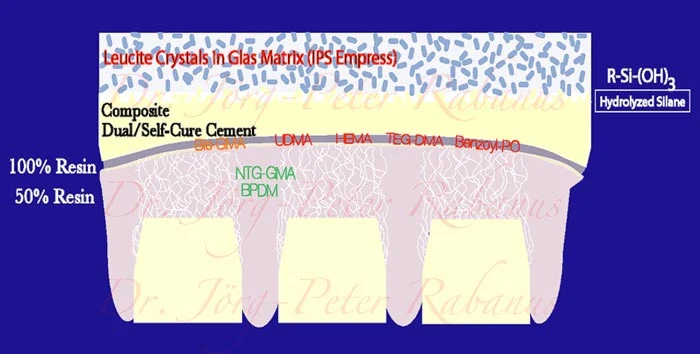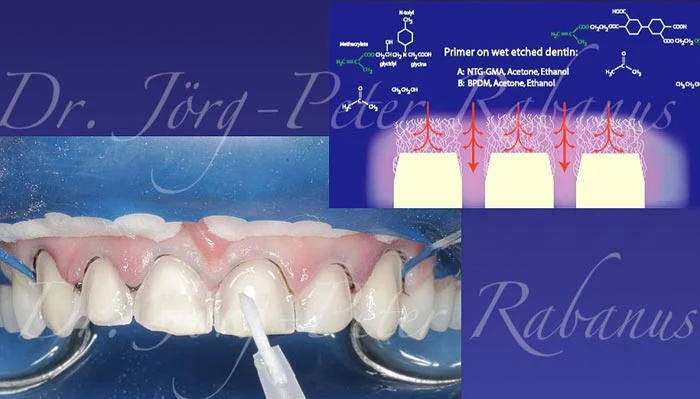Porcelain veneers are made of ceramics that have the same principle components as any other porcelains. And we are well aware of the risk of breaking porcelain vase or a ceramic tile.
So, why are porcelain veneers so strong?

Depiction of all elements that contribute to a porcelain veneer that is as strong as natural tooth structure.
(Find a better resolution on your desktop.)
Porcelains are very hard and strong to compression. In this aspect, they compare with dental enamel. However, their inherent weakness (brittleness) to shearing and tension would make them prohibitive for their use for dental veneers or other cosmetic restorations. However, dental research has developed various generations of chemicals that interact with the surface dentin on one side and the intaglio surface of a porcelain restoration on the other side, leading to a hybrid layer that consists of various sublayers, each of which is created by its own chemical and/or physical interaction to the next sublayer from organic to anorganic. Only the event of dentin bonding has allowed cosmetic dentistry to incorporate porcelains as one of its most successful dental materials.

In addition to advanced dental technology and materials, the experienced cosmetic dentist understands how any dental agent chemically interacts with the prepared tooth surface and meticulously applies his knowledge and experience, leading to porcelain veneers that are virtually integrated (via hybrid zones) to biological structure, not just attached. This is why the survival rate of dental veneers has been in the 96% area even after more than 20 years.
Dental enamel is so resilient and tough that a synthetic enamel has been successfully recreated by growing zinc oxide nanowires on a chip and layering forty layers of two polymers over it by special treatment, to create a micrometer of enamel-like structure. which was then repeated up to 20 times. Dr. Nicholas Kotov of Ann Arbor stated that the outstanding mechanical properties of biological materials derive from an intricate molecular adaptation of soft structures to hard ones and vice versa. These materials may be the future of porcelain veneers.
However, for the time being, dentin bonding has allowed the best cosmetic dentists who understand every individual step necessary to clinically create a perfectly bonded dental laminate.
References:
AlJazairy YH. Survival Rates for Porcelain Laminate Veneers: A Systematic Review. Eur J Dentistry, 2021; 15(2); 360-368.
Passia N et al.Tensile bond strength of different universal adhesive systems to lithium disilicate ceramic. J Am Dent Assoc, 2015; 146(10); 729-734.
Venturini AB. Effect of Hydrofluoric Acid Concentration on Resin Adhesion to a Feldspathic Ceramic. J Adhesive Dentistry, 2015; 17(4); 313-320.
Sasse M et al. Influence of restoration thickness and dental bonding surface on the fracture resistance of full-coverage occlusal veneers made from lithium disilicate ceramic. Dental Materials, 2015; 31(8); 907-915.
Haupt J. Guidelines for selecting the right all-ceramic material for a successful restoration. J Cosmetic Dentistry, 2007; 23(3); 94-100.
Lambade DP et al. Evaluation of adhesive bonding of lithium disilicate ceramic material with duel cured resin luting agents. J Clin Diagn Res, 2015; 9(2);
Spear FM et al. Which all-ceramic system is optimal for anterior esthetics? J Am Dental Association, 2008; 139 (Suppl.); 19S-24S.
Radz GM et al. Full-arch rehabilitation utilizing pressed ceramic veneers and full-coverage crowns. Pract Periodontics Aesthetic Dentistry, 1998; 10(5); 629-634.
Cho GC. Rational use of contemporary all-ceramic crown systems. J Calif Dental Association, 1998; 26(2); 113-120.
Aboushelib MN. Microtensile bond strength of lithium disilicate ceramics to resin adhesives. J Adhes Dentistry, 2014; 16(6); 547-552.
He M et al. Effect of sandblasting on surface roughness of zirconia-based ceramics and shear bond strength of veneering porcelain. J Dent Mater, 2014; 33(6); 778-785.
Touati B. Innovative dental ceramics: expanding the material alternatives. Pract Proced Aesthetic Dentistry, 2005; 17(5); 357-358.
Helvey GA. Using pressable ceramics to achieve orthodontic correction. Pract Proced Aesthetic Dentistry, 2002; 14(3); 223-227.
Griggs JA. Recent advances in materials for all-ceramic restorations. Dental Clinics North Am, 2007; 51(3); 713-727.
Kristallis TT. Optimal aesthetics using porcelain laminate veneers: clinical and laboratory considerations. Pract Proced Aesthetic Dentistry, 2005; 17(5); 323-325.
Gutmann JL. The evolution of America's scientific advancements in dentistry in the past 150 years. J Am Dental Assoc, 2009; (140(1); 8S-15S.
Adar P. The synergistic approach to treatment planning and product selection. J Cosmetic Dentistry, 2007; 23(2); 88-93.
Ritter RG et al. Material considerations for using lithium disilicate as a thin veneer option. J Cosmetic Dentistry, 2009; 25(3); 111-117.
Leinfelder KF. Porcelain esthetics for the 21st century. J AM Dental Assoc, 2000; 131 Suppl.; 47S-51S.
Raigrodski AJ. All-ceramic full-coverage restorations: concepts and guidelines for material selection. Pract Proced Aesthetic Dentistry, 2005; 17(4); 249-256.
Devaud V. State of the art in indirect restorations. AACD Monograph, 2010.
Nakamura M et al. The 24-year clinical performance of porcelain laminate veneer restorations bonded with a two-liquid silane primer and a tri-n-butylborane-initiated adhesive resin. J Oral Sci, 2014; 56(3); 227-230.
Hornbrook D. The Indirect Aesthetic Restoration: Pressed and Powder-Liquid Ceramics. AACD Monograph, 2010.
Bayne SC. Dental restorations for oral rehabilitation - testing of laboratory properties versus clinical performance for clinical decision making. J Oral Rehabilitation, 2007; 34(12); 921-932.
Donavan TE. Factors essential for successful all-ceramic restorations. J AM Dental Assoc, 2008; 139 Suppl. 14S-18S.
Chiche GJ. Application of microetching to all-ceramic crown techniques. Esthetic Dentistry, 1998; 10(5); 626.
Rekow D. Can material properties predict survival of all-ceramic posterior crowns? Compend Contin Educ Dentistry, 2007; 28(7); 362-368.
Stappert C. Survival rate and fracture strength of maxillary incisors, restored with different kinds of full veneers. J Oral Rehabilitation, 2005; 32(4); 266-272.
Burke FJ et al. Effect of differing resin luting systems on fracture resistance of teeth restored with dentin-bonded crowns. Qintessence Int, 1998; 29(1); 21-27.
Xiaoping L et el. Effect of etching time and resin bond on the flexural strength of IPS e.max Press glass ceramic. Dental Materials, 2014; 30(12); 330-336.
Snead ML. Science is the fuel for the engine of technology and clinical practice. J Am Dental Assoc, 2009; 140 Suppl 1; 17S-24S.
Della Bona A et al. The clinical success of all-ceramic restorations. J Am Dental Assoc, 2008; 139 Suppl; 8S-13S.
Martin MP. Material and clinical considerations for full-coverage indirect restorations. Compend Contin Educ Dent, 2012; 33(6); 2-5.
Prieto LT et al. Knoop hardness and effectiveness of dual-cured luting systems and flowable resin to bond leucite-reinforced ceramic to enamel. J Prosthodont, 2013; 22(1); 54-58.
El-Sheikh M et al. Tensile bond strength of four denture resins to porcelain teeth with different surface treatment. J Adv Prosthodont, 2013; 5(4); 423-427.
Menees TS et al. Influence of particle abrasion or hydrofluoric acid etching on lithium disilicate flexural strength. J Prosthetic Dentistry, 2014; 112(5); 1164-1170.
Mörig G. Aesthetic all-ceramic restorations: a philosophic and clinical review. Pract Periodontics Aesthetic Dentistry, 1996; 8(8); 741-749.
Pegoraro TA. Cements for Use in Esthetic Dentistry. Dental Clincs North Am, 2007; 51(2); 453-471.
Alavi AA et al. The Shear Bond Strength of Porcelain Laminate to Prepared and Unprepared Anterior Teeth. J Dent (Shiraz), 2017; 18(1); 50-55.
Scotti N et al. Effect of Lithium Disilicate Veneers of Different Thickness on the Degree of Conversion and Microhardness of a Light-Curing and a Dual-Curing Cement. Int J Prosthodontics, 2016; 29(4); 384-388.



